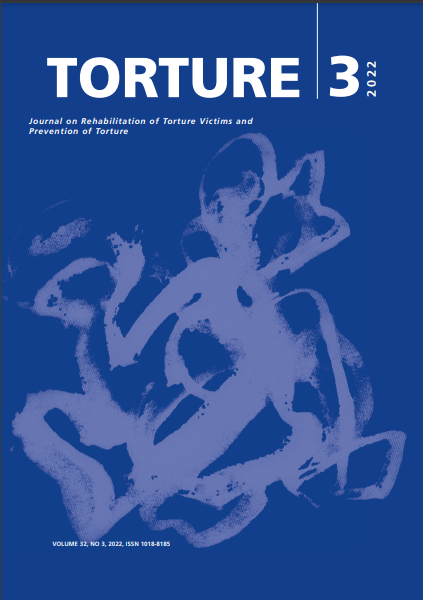The manipulation of minds: reckoning with the legacy of the American post 9/11 torture program
DOI:
https://doi.org/10.7146/torture.v32i3.131962Keywords:
Guantanamo Bay, torture programAbstract
In this article, we argue that the government’s post 9-11 torture program was a big lie, in that the designers, executors and enablers knew all along that torture does not elicit reliable information. We review the government’s own research on the matter, and we discuss the ways in which methods known to be unreliable were implemented, most saliently at the detention facility at Guantánamo Bay. We review the secrecy and propaganda surrounding the scope and horror of the torture program at Guantánamo and black sites around the world, and how the government knowingly adopted the terror policies of the torture program, against their own knowledge, against international human rights, and against the law.
References
Apuzzo, M., Fink, S., & Risen, J. (2016). How U.S. torture left a legacy of damaged minds. New York Times. Retrieved from https://www.nytimes.com/2016/10/09/world/cia-torture-guantanamo-bay.html
Biederman, A. (1956). Communist attempts to elicit false confessions from Air Force prisoners of war. Retrieved from https://www.ncbi.nlm.nih.gov/pmc/articles/PMC1806204/pdf/bullnyacadmed00378-0046.pdf
Bravin, J. (2013). The terror courts: Rough justice at Guantánamo Bay. Yale University Press.
Center for Constitutional Rights. (2020). Mohammed al Qahtani. Retrieved from https://ccrjustice.org/mohammed-al-qahtani
Committee on Armed Services, United States Senate (2008). Inquiry into the treatment of detainees in U.S. custody. Retrieved from https://www.armed-services.senate.gov/imo/media/doc/Detainee-Report-Final_April-22-2009.pdf
Ellsberg, D. (2003). Secrets: A Memoir of Vietnam and the Pentagon Papers. Penguin.
Fallon, M. (2017). Unjustifiable means: The inside story of how the CIA, Pentagon and US government conspired to torture. Regan Arts.
Glaberson, W. (2009). Detainee was tortured, a Bush official confirms. New York Times. Retrieved from https://www.nytimes.com/2009/01/14/us/14gitmo.html?referringSource=articleShare
The Guantánamo Docket (2022). Retrieved from https://www.nytimes.com/interactive/projects/Guantánamo/detainees/current
Harris, S., & Mak, T. (2014). The most gruesome moments in the CIA torture report. Daily Beast. Retrieved from https://www.thedailybeast.com/the-most-gruesome-moments-in-the-cia-torture-report
Honigsberg, P. (2017). The Consequences today of the United States’ Brutal Post-9/11 Interrogation Techniques. Notre Dame Journal of Law, Ethics & Public Policy, 31(1), 29.
Iacopino, V., & Xenakis, S. N. (2011). Neglect of Medical Evidence of Torture in Guantánamo Bay: A Case Series. PLOS Medicine, 8(4), e1001027. https://doi.org/10.1371/journal.pmed.1001027
Joscelyn, T. (2011). Did enhanced interrogation of the 20th hi-jacker help identify Bin Laden’s courier? Washington Examiner. Retrieved from ttps://www.washingtonexaminer.com/weekly-standard/did-enhanced-interrogation-of-the-20th-hijacker-help-identify-bin-ladens-courier
Johnson, L. K. (2015). A Season of Inquiry: The Senate Intelligence Investigation. University Press of Kentucky.
Ladin, D. (2016). In secret email, CIA’s chief lawyer mocked ‘pesky little international obligations’. Retrieved from https://www.aclu.org/blog/national-security/torture/secret-email-cias-chief-lawyer-mocked-pesky-little-international?redirect=blog/speak-freely/secret-email-cias-chief-lawyer-mocked-pesky-little-international-obligations
Leopold, J. (2015). How Guantanamo became America’s interrogation battle lab. Retrieved from https://www.vice.com/en/article/xwpb84/how-Guantánamo-became-americas-interrogation-battle-lab
Luban, D., & Newell, K. S. (2019). Personality Disruption as Mental Torture: The CIA, Interrogational Abuse, and the US Torture Act. Georgetown Law Journal, 108, 333.
Mazzetti, M. (2014). Panel faults CIA over brutality and deceit in terrorism interrogations. New York Times. Retrieved from https://www.nytimes.com/2014/12/10/world/senate-intelligence-committee-cia-torture-report.html
National Commission on Terrorist Attacks Upon the United States (2004). Retrieved from https://govinfo.library.unt.edu/911/report/911Report_Ch8.htm
Ross, T (2011) Courier’s phone ‘led US directly to compound’. The Independent. Retrieved from https://www.independent.ie/world-news/middle-east/couriers-phone-call-led-us-directly-to-compound-26729256.html
Rozin, P., & Haidt, J. (2013). The domains of disgust and their origins: Contrasting biological and cultural evolutionary accounts. Trends in Cognitive Sciences, 17(8), 367–368. https://doi.org/10.1016/j.tics.2013.06.001
Rumann, C. (2010). Use of female interrogators: The analysis of sexualized interrogations the detainee interrogation working group did not conduct. Hastings Women's Law Journal, 21, 273.
Senate Select Committee Study of the Central Intelligence Agency Detention and Interrogation Program (2014). Retrieved from https://www.govinfo.gov/content/pkg/CRPT-113srpt288/pdf/CRPT-113srpt288.pdf
Zagorin, A., & Duffy, M. (2005). Inside the interrogation of detainee 063. Time Magazine. Retrieved from https://time.com/3624326/inside-the-interrogation-of-detainee-063/
Downloads
Published
How to Cite
Issue
Section
License
Copyright (c) 2022 Torture Journal

This work is licensed under a Creative Commons Attribution-NonCommercial-NoDerivatives 4.0 International License.
We accept that some authors (e.g. government employees in some countries) are unable to transfer copyright. The Creative Commons Licence Attribution-NonCommercial-NoDerivatives 4.0 International (CC BY-NC-ND 4.0) covers both the Torture Journal and the IRCT web site. The publisher will not put any limitation on the personal freedom of the author to use material contained in the paper in other works which may be published, provided that acknowledgement is made to the original place of publication.


